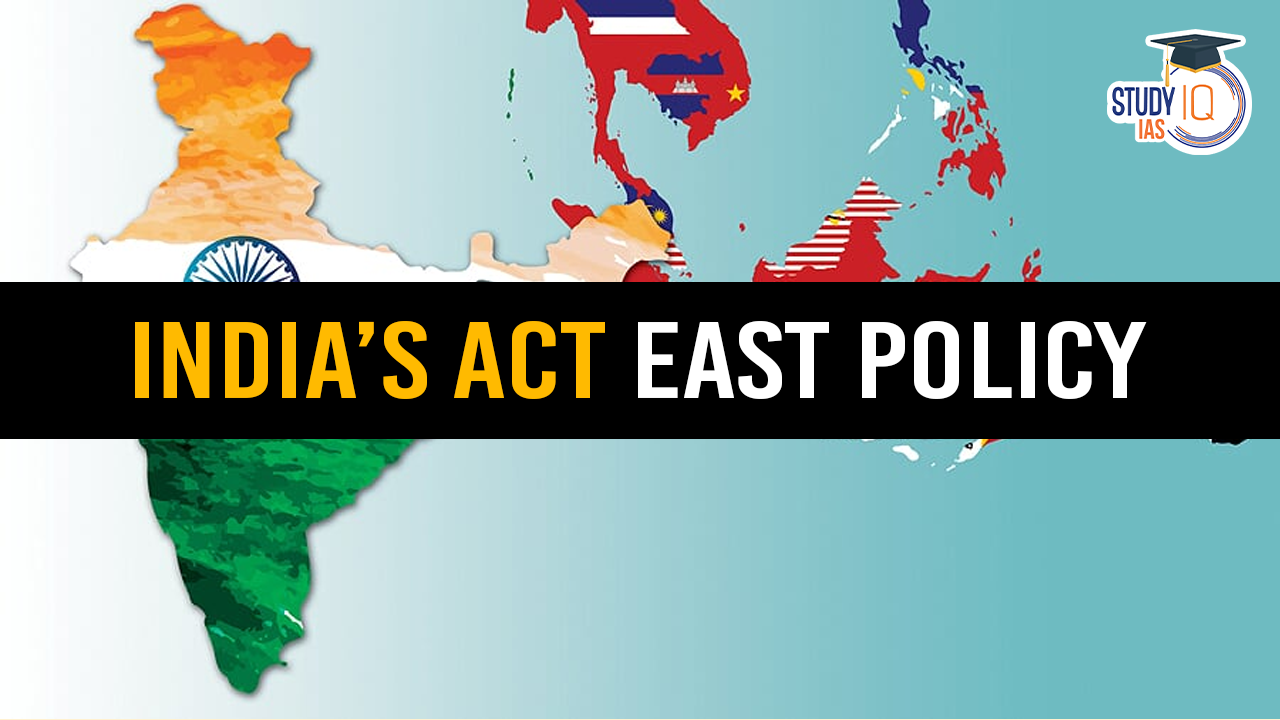Table of Contents
Context: Indian Railways commissioned a new 51.38 km rail line to Sairang near Aizawl, boosting regional connectivity and strengthening the Act East Policy, despite cross-border project delays due to regional instability.
What is India’s Act East Policy?
- The Act East Policy, introduced in November 2014, is an enhanced version of the “Look East Policy.”
- The policy focuses on sustained engagement with Southeast Asian nations in areas such as connectivity, trade, culture, defence, and people-to-people exchanges at bilateral, regional, and multilateral platforms.
Aim
- Aims to transition India’s approach from passive observation (“Look”) to active regional participation (“Act”).
- The primary goal is to strengthen economic cooperation, cultural ties, and strategic relations with Indo-Pacific countries through a proactive and practical approach.
- The policy also seeks to boost the economic development of India’s North Eastern Region (NER), serving as a gateway to Southeast Asia.
| About the Look East Policy |
|
Objectives of the Act East Policy
- Enhance economic engagement through increased trade, investment, and market access in the Indo-Pacific region.
- Deepen cultural understanding and people-to-people relations via educational and cultural exchanges.
- Build long-term strategic partnerships through bilateral, multilateral, and regional dialogues.
- Promote regional cooperation and integration in political, economic, and socio-cultural domains.
- Collaborate on shared challenges like terrorism, maritime security, and disaster management.
Three Pillars of the Act East Policy
1. Economic Pillar:
- Integration with global supply chains
- Boost trade and investment in East and Southeast Asia
2. Socio-Cultural Pillar:
- Foster mutual understanding
- Promote shared cultural and civilizational links
3. Political-Security Pillar:
- Enhance defense cooperation
- Promote regional stability and balance of power
Key Features
- ASEAN-Centric Approach: Close alignment with ASEAN and participation in ARF, EAS, and ADMM+.
- 4C Framework: Focus on Culture, Commerce, Connectivity, and Capacity Building.
- Strategic Security Ties: Partnerships with countries like Japan, Vietnam, and the Philippines.
- Connectivity & Infrastructure Focus: Cross-border highways, rail links, and digital platforms.
- Multilateral Engagement: Active participation in ASEAN, BIMSTEC, and EAS for regional cooperation.
Difference Between The Look East Policy And Act East Policy
| Aspect | Look East Policy | Act East Policy |
| Focus | Primarily on ASEAN countries and economic integration. | Focus on ASEAN countries + East Asian countries + Security cooperation. |
| Launch | Initiated in 1992 by Prime Minister P. V. Narasimha Rao. | Introduced in 2014 by Prime Minister Narendra Modi. |
| Key Partner | ASEAN (Association of Southeast Asian Nations). | ASEAN + East Asian countries + Indo-Pacific region. |
| Economic Integration | Economic engagement through trade and partnerships. | Economic integration with added emphasis on connectivity and commerce. |
| Security Cooperation | Limited focus on security cooperation. | Security cooperation, especially in response to China’s assertiveness in the South China Sea and the Indian Ocean. |
| Strategic Focus | Establishing India as a regional power and counterweight to China. | Securing freedom of navigation in the Indo-Pacific and engaging with the Quad. |
Major Projects under Act East Policy
- India-Myanmar-Thailand Trilateral Highway – Boosts road connectivity.
- Kaladan Multi-Modal Transit Project – Connects eastern ports of India with Myanmar’s Sittwe port.
- Agartala–Akhaura Rail Link – Enhances connectivity between Northeast India and Bangladesh.
- Digital Public Infrastructure (DPI) – Advances digital ties through the India-ASEAN Fund.
- Mekong–India Economic Corridor – Links India’s east coast with Southeast Asia.
- ITEC Programme – Capacity building for Cambodia, Laos, Vietnam, etc.
- International Buddhist Confederation (IBC) – Promotes shared Buddhist heritage.
- BIMSTEC Initiatives – Encourage regional cooperation around the Bay of Bengal.
Initiatives to Enhance Connectivity under Act East Policy
- Agartala-Akhaura Rail Link: This rail link between India and Bangladesh aims to strengthen regional connectivity.
- Intermodal Transport and Inland Waterways: Initiatives include linking transport modes and utilising inland waterways through Bangladesh to improve trade routes.
- Kaladan Multimodal Transit Transport Project & Trilateral Highway: These projects aim to connect India’s North East with Myanmar and Thailand, enhancing connectivity with Southeast Asia.
- India-Japan Act East Forum Projects: Under this forum, projects like road and bridge construction and hydroelectric power modernization have been initiated.
- India-Japan Act East Forum (2017): Established to collaborate on India’s “Act East Policy” and Japan’s “Free and Open Indo-Pacific Strategy,” the forum focuses on modernising the North-East region’s infrastructure and promoting people-to-people exchanges.
- Support During the Pandemic: India extended medical assistance, including medicines and supplies, to ASEAN countries during the COVID-19 pandemic.
- PhD Fellowships for ASEAN Participants: India offered 1000 PhD fellowships at IITs for participants from ASEAN countries to foster academic collaboration.
- Quick Impact Projects (QIPs): India is implementing small-scale, low-cost development projects in Cambodia, Laos, Myanmar, and Vietnam, targeting areas like education, water resources, and health.
- Coastal Shipping and Inland Water Transport Initiatives: To increase the modal share of coastal shipping, 46 initiatives were identified under the Amrit Kaal Vision 2047, focusing on port-based centres, coastal berths, and improving road, rail, and inland water infrastructure.
Significance Of India’s Act East Policy
- Counterweight to China: India’s proactive Act East policy positions it as a counterbalance to China’s aggressive behaviour in the South China Sea and the broader Indo-Pacific region.
- This is particularly important for countries like Vietnam, the Philippines, and others that face territorial disputes with China.
- Strategic Outreach: The BrahMos missile deal between India and the Philippines, signed in 2022, highlights India’s growing strategic presence in Southeast Asia.
- By providing the Philippines with military support, India strengthens its role in regional security, specifically against China’s assertiveness.
- Regional Security Cooperation: India’s active participation in regional security forums like the 2+2 Ministerial Dialogue with Japan and the Quadrilateral Dialogue (Quad) shows its increased engagement in the evolving security architecture of the Indo-Pacific.
- Economic and Diplomatic Engagement: India’s deepening relationships with countries like South Korea and Japan, which share concerns about China, underscore the growing strategic partnership in the Indo-Pacific region.
- Impact of Bangladesh’s Political Developments: Bangladesh’s significance in operationalising the Act East policy is noted.
- Concerns about potential challenges if a less friendly government comes into power, which could affect regional cooperation and initiatives like BIMSTEC.
- Strengthened Role in the Indo-Pacific: Over the years, India has successfully transitioned from the Look East policy to the Act East policy, expanding its footprint in Southeast Asia and the Indo-Pacific.
- India is becoming an integral part of the region’s security and economic landscape.
Challenges to Act East Policy
Dealing with China: India faces dual strategies from China.
- China encircles India through initiatives like the “string of pearls” and the China-Pakistan Economic Corridor (CPEC) in disputed territories.
- Simultaneously, China seeks India’s cooperation on global issues like climate change and globalisation.
Steps for an Assertive Act East Policy
Tackling China
- As China asserts its presence in the Indian Ocean, India should increase its engagement in the South China Sea.
- Collaboration with the Quad and ASEAN countries is crucial, along with India’s partnership with Vietnam in oil exploration in the South China Sea.
- India is also working with Indonesia to develop the Sabang port near the strategic Strait of Malacca.
- The Indo-Pacific Oceans Initiative focuses on partnerships for maritime security, sustainable use of marine resources, and disaster prevention and management.
Developing North East
- The success of the Act East Policy relies heavily on improving connectivity in India’s North East region.
- Projects like the India-Myanmar-Thailand Trilateral Highway and the Kaladan Multi-Modal Transit Transport Project need to be expedited to enhance connectivity.
Leveraging Soft Power
- India should focus on its cultural and civilizational strengths while pursuing the Act East Policy, as the region shares ancient ties through Buddhism and Hinduism.
- India’s freedom fighters also forged historical connections with Southeast and East Asia.
- In modern times, India’s cultural influence has expanded due to globalisation and technological advances.
- The Indian diaspora plays a key role in strengthening people-to-people connections, further enhancing India’s cultural and civilizational ties in the region.


 Iran Nuclear Crisis and India’s Role f...
Iran Nuclear Crisis and India’s Role f...
 H1B Visa Program, Beneficiaries, Eligibi...
H1B Visa Program, Beneficiaries, Eligibi...
 Comparison Between India & France's ...
Comparison Between India & France's ...

























